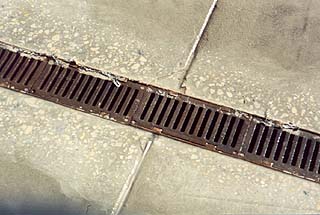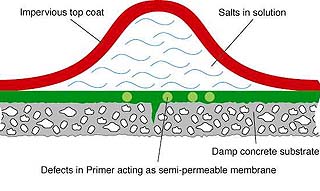|
Subscribe / Renew |
|
|
Contact Us |
|
| ► Subscribe to our Free Weekly Newsletter | |
| home | Welcome, sign in or click here to subscribe. | login |
Construction
| |
 |
May 2, 2003
Nix the blisters for a smooth complexion
Liquid Plastics

Images courtesy of Liquid Plas
Osmotic blistering around a drain area.
|
Imagine that you’ve just spent thousands of dollars laying down a new concrete floor for your office or plant. You’ve coated it with the latest decorative epoxy finish, but to your horror, just days after the application you start seeing blisters appear.
Your floor is ruined, lots of money has gone down the drain and you’ve joined thousands who have learned first-hand of the effect of osmotic blistering.
You may remember osmosis from high school chemistry class. It’s the phenomenon by which solutions try to reach equilibrium across a semi-permeable membrane. Water will flow from a more dilute solution to a more concentrated one when separated by a semi-permeable membrane. Such membranes allow for the passage of water but not a dissolved substance. When osmosis occurs in construction, the results are disastrous.
I see a lot of cases of osmotic blistering in new construction because the bond interface of the newly coated concrete slab acts as a semi-permeable membrane. The osmosis process continues until either equilibrium is met or until the hydrostatic pressure generated by the increase in volume of the more concentrated solution equals that of the osmotic pressure. In the case of a coated concrete floor, the pressure builds up at the interface between the coating and the concrete and causes blistering and progressive disbondment.
In order for osmotic blistering to occur, three things are needed:
- A semi-permeable membrane, which in most construction cases is the bond interface or the extreme upper layer of the concrete.
- A concentration of water-soluble material, which can be anything from the resin ingredients in the epoxy coating to the material that can form at the surface of concrete when it is acid etched. Adding to the problem is the fact that Portland cement also has a naturally occurring soluble salt content that can also act as a catalyst for osmotic blistering.
- Water. Even when we think concrete is dry, it still contains up to 5 percent of free water by weight. This is enough moisture to start the osmotic blistering process. Adding to the problem are other outside moisture sources like groundwater, drains, water left over from cleaning processes, condensation or the Northwest’s wet climate.
The worst part about osmotic blistering is there really is no litmus test to determine whether it will occur. I’ve seen it occur in projects that were six months old and projects that were six days old.
What can companies do to reduce the chances of osmotic blistering?
- If possible, minimize the amount of soluble salts in the concrete design mix.
- Let the concrete dry for at least two months and/or ensure a fully functional water vapor barrier is underneath the slab when placed.
- Avoid acid etching as surface preparation for a coating application.
- Don’t wash the concrete with detergent before applying coating.
- Ensure that the epoxy coating resin constituents are accurately proportioned and mixed.
Obviously some of those options aren’t viable when it comes to timely construction. Worse yet, most of the extreme cases of osmotic blistering will occur even if these suggestions are followed.

The osmotic blistering process.
|
For example, if a floor lies below grade it is extremely susceptible to osmotic blistering because of higher moisture contents. My company worked on such a project at the Hong Kong International Airport where the 600,000-square-foot baggage handling area lies 14 feet below sea level and is fully saturated with salt water. We were called in as they were close to finishing the facility and realized that a conventional epoxy coating system would not function over such a fully saturated slab.
We used the site as a test for one of our products called Cemprotec E-Floor, which is based on an epoxy called metakaolin and Portland cement-modified polymer coating. The key was to create a dense matrix that could resist hydrostatic pressure and still allow the passage of water vapor. This allowed the damp substrates to breathe by dissipating the water vapor into the coating without the build up of pressure and subsequent surface blistering.
Since the application in Hong Kong, the coating system has been performing perfectly, without blistering.
The amazing thing about osmotic blistering is most people in the construction industry know very little about it.
Just this year I was contacted about a problem at a major beverage distributor that had one of its Texas warehouses ruined by osmotic blistering. And last year I consulted on a project in Haverhill, Mass., where osmotic blistering occurred only six days after the application of a saturated primer. The contractor had to strip the floor, but was able to recoat it by applying E-Floor first.
Because of the success of the Haverhill project, our relationship developed with the epoxy manufacturer to the point where we now work together when there are moisture problems. We’ve done projects with the firm in places like Sea World where the high moisture content would make it nearly impossible for any typical coating to work.
Osmotic blistering is one of the least understood problems in the construction industry.
For some projects, it’s just not possible to prevent osmotic blistering, except with the use of E-Floor. Places like the Hong Kong Airport, Sea World and other areas where water is a constant menace will always present a challenge.
It’s clear that engineers will always have to be on the lookout for the conditions that can cause osmotic blistering and take proactive steps to prevent it from happening, or risk the consequences.
Marc Schroeder is president of Liquid Plastics, a company that makes protective coating membranes and concrete repair materials. For more information, call (888) 635-5228 or visit www.liquidplasticsinc.com.
Other Stories:
- Skate park shreds gnarly drug dealers
- Post-tension that concrete building?
- Scenic canyon tests concrete’s beauty


